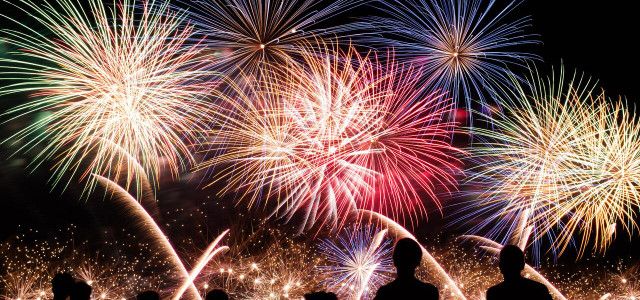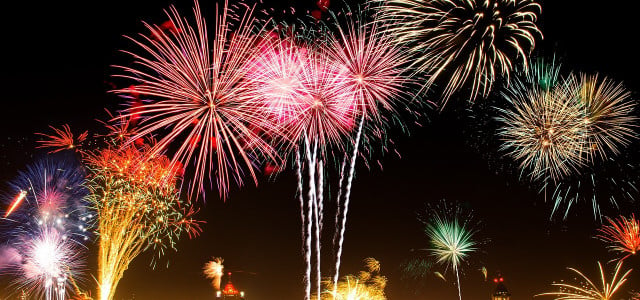Fireworks can charm and excite us, and scare animals and other wildlife. Who invented them, and how are fireworks made? Are they a problem for the environment?
Love them or hate them, most people can remember an impressive fireworks display. Big productions abound during celebrations and holidays. You may even have fond memories of setting off fireworks in your backyard. But how much do you know about them?
The roots of modern-day fireworks, as well as their cultural significance, are easy to trace. It is important now, especially with our increased awareness of Earth’s fragility, to re-examine certain long-established practices — especially where valid alternatives exist. To do so, we need to know how things are made and their effect on the environment.
So how are fireworks made, and how do they work? Read on for all the details and interesting facts about fireworks.
1. What Are Fireworks?

Fireworks are devices that create light and sound via combustion or explosions. They range from large-scale aerial devices to small handheld sparklers. All fireworks are considered pyrotechnics. Whereas most fireworks are fast and furious, sparklers and other smaller apparatuses burn for a longer time — though they are still relatively quick to burn out.
Large fireworks, including rockets, create their effects through a series of rapid explosions, whereas sparklers, for instance, throw off sparks of bright white light from the end of short handheld sticks. Meanwhile, firecrackers are small devices lit with fuses that focus on creating loud pops and bangs.
Fireworks often contain aluminum for fuel, which is sometimes combined with iron, steel, zinc or magnesium dust. These chemicals create explosions and beautiful visual effects. The elements heat up extremely quickly, shining brightly until they burn out. Other variations of chemicals can be used to create different colors and hues.
2. How Are Fireworks Made and How Do They Work?

Modern fireworks comprise a shell of plastic, papier-mache or heavy paper, separated and surrounded by cardboard compartments. A packed black powder, made of a mixture of potassium nitrate, charcoal and sulfur, is at the firework’s base and is engineered to propel it quickly into the sky. Other chemicals are added to different compartments, often called “stars,” to produce various lights and colors. They are heat activated.
Fireworks’ makeup can vary. For example, American and European stars are typically located inside a cylindrical compartment. Upon explosion, they scatter randomly. In Asian fireworks, the stars often surround the black powder in a spherical chamber for a more symmetrical display of light.
Fireworks that produce a series of loud bangs usually contain flash powder instead of black powder and stars. They may also have fuses attached to gunpowder. Flash powder consists of a mix of potassium chlorate (or potassium perchlorate), sulfur and aluminum.
Fireworks need fuel, coloring agents and oxidizers to burn. These fuels, oxidizers and coloring agents can include charcoal, chlorine, red gum, aluminum, magnesium, titanium, and carbon. So you can see that fireworks leave a significant chemical mark — especially in large and ambitious displays.
Small fireworks, like those intended for private use (for example, firecrackers and Roma candles), follow a similar design but are simpler in construction and somewhat less explosive. They are often in the form of paper tubes containing smaller amounts of chemicals and explosives. Occasionally they hold no explosive, as in the case of smoke balls; however, they’re still packed with chemicals that aren’t great for our lungs or air quality.
Handheld sparklers are made with a metal wire dipped into a mix of fuel, oxidizing agents, coloring agents and granules of aluminum, the triggering agent for sparks.
Now that we know how fireworks are made, who invented them — and when?
3. When Were Fireworks Invented?

Interestingly, while they’ve been around for a long time, fireworks likely evolved by accident. Historians suggest that fireworks were invented in Liuyang, China, in the second century BC. The first examples of what we consider fireworks may have resulted from bamboo stalks exploding when thrown into fire. Hollow air pockets within bamboo create a bang when exposed to extreme heat.
Fireworks took their next evolutionary turn around 200 BC when Chinese alchemists mixed sulfur, charcoal, and potassium nitrate in a bid to find the secret to eternal life.
Modern fireworks appeared in their current form when saltpeter was added to the mixture to get black powder, which is considered the first human-produced chemical explosive. This didn’t occur until roughly a thousand years later.
4. Who Invented Fireworks?

As mentioned above, fireworks and black powder most likely originated in China. Once the bright, loud chemical reactions could be controlled, they were used to ward off evil spirits and later developed into rockets that could be fired at enemies. Similar rockets remain in use in modern fireworks displays. However, it’s possible that black powder was discovered in the Middle East around the same time.
As to who exactly invented fireworks, the history is a little murky. We do know that by the 14th century, black powder was commonly used throughout Europe as an explosive for fireworks and weaponry.
5. Cultural Significance of Firework Displays

Far East:
Fireworks are a big part of life in Asia and are frequently used year-round to celebrate religious holidays. Tokyo, for example, has many festivals where fireworks are set off, along with fireworks competitions and street parties.
The Hindu festival of Diwali (The Festival of Light) is one of the most widely known festivals, full of lights, noise and color. India has an array of celebrations throughout the year, also correlating with holidays, where you can see beautiful firework displays.
Europe:
The use of fireworks in Europe expanded alongside the use of military explosives, with military fireworks experts pressed into conducting pyrotechnic displays to celebrate victory and peace. Now they are mainly used to mark holidays and significant cultural events.
Guy Fawkes is a well-known figure associated with fireworks in the UK, but other countries also observe Guy Fawkes Day on the 5th of November each year. Also called Bonfire Night, or Fireworks Night, this event celebrates Guy Fawkes’ foiled plot to blow up the houses of parliament in London.
Italy often produces lavish displays, launched from decorated wooden sets and water decks. Italians are also thought to have been responsible for adding colors to fireworks. That may be why Italy, in addition to China, is still one of the largest producing countries of fireworks, along with Germany, France and the Netherlands.
United States:
In the US, fireworks are often used to celebrate Independence Day on July 4th. The first official firework celebration of independence is believed to have been in 1977.
6. Are Fireworks Bad for the Environment?

By their nature, fireworks are loud and noticeable. They scare and unnerve animals, some even succumbing to death by shock. According to one report out of the UK, horses in particular can die from the fright associated with fireworks. In addition, the sounds can startle and stress family pets, and bats, birds and animals close to explosions or detonation sites can experience sonic shock.
Noise pollution is a very real and pressing problem. Check out our article What Is Noise Pollution? 5 Examples and Solutions for more examples.
Along with the upset and confusion fireworks can cause, there is the question of pollution and the risk of wildfires. For example, sparklers cannot be recycled, and many chemicals used to create fireworks are toxic.
Then, there are the remnants to consider. The littered casings left behind after a grand display are made of plastic, which won’t degrade. Animals can also ingest it. As we all figure out how to go plastic-free, it’s worth considering these extra, seemingly harmless assaults on the environment.
In many ways, it’s obvious that blowing things up can negatively impact the environment. So, does that mean we should look for safer, less damaging alternatives to fireworks? What would they look like?
7. Eco-friendly Alternatives


Some of the technologies below are expensive or aren’t yet widely available, and some require specialist training. But changes are on the horizon as more and more people shift how they think about the environment.
We don’t want to lose the chance to celebrate together and enjoy spectacular visual shows, so what are our options?
- Drones. Drone light shows are becoming common in large-scale festivities. These shows don’t produce chemical or noise pollution. The electronics in many drones are also recyclable and produce no waste (but this may not apply to any damaged plastic casing). Becoming more and more popular at large-scale events such as Disney Theme Parks and Superbowl events.
- Laser shows. Another low-pollution and low-chemical option, unfortunately, laser shows do still contribute to light pollution (as do drone shows). You can get dazzling displays with lasers, and the risk of injury is also minimized.
- Glow sticks. These can replace sparklers, but it may be switching one environmental problem for another, as the plastic tubing used is often not eco-friendly. Most are made of single-use plastic and cannot be recycled.
- Wildflower cannons can be fun and unusual, with the added benefit of creating new wild meadows. Use them in your garden or where you know you are allowed to.
- Consider a giant bubble party. Bubbles are often created just with water, glycerin and soap — but if you’d like bubble solution without glycerin, there are options for that, too.
- You can also light up your event with eco-friendly string lights. Opt for LEDs.
- Host a different type of party to celebrate, such as an eco-friendly BBQ, picnic or pot-luck.
Do Eco-friendly Options Exist?
Some companies are moving toward producing fireworks that don’t need as many toxic chemicals. These may emit fewer pollutants than traditional fireworks, but their effect on air quality is still a problem. Also, the risk of shock and injury remains. There is little scientific evidence for eco-friendly fireworks at this time.
Read more:
- Glow-in-the-Dark Trees — A Realistic Solution for Streetlights?
- Human-Environment Interaction: Definition & Examples
- Why Eating Meat Is Considered Masculine & Being Vegan Isn’t
Do you like this post?







